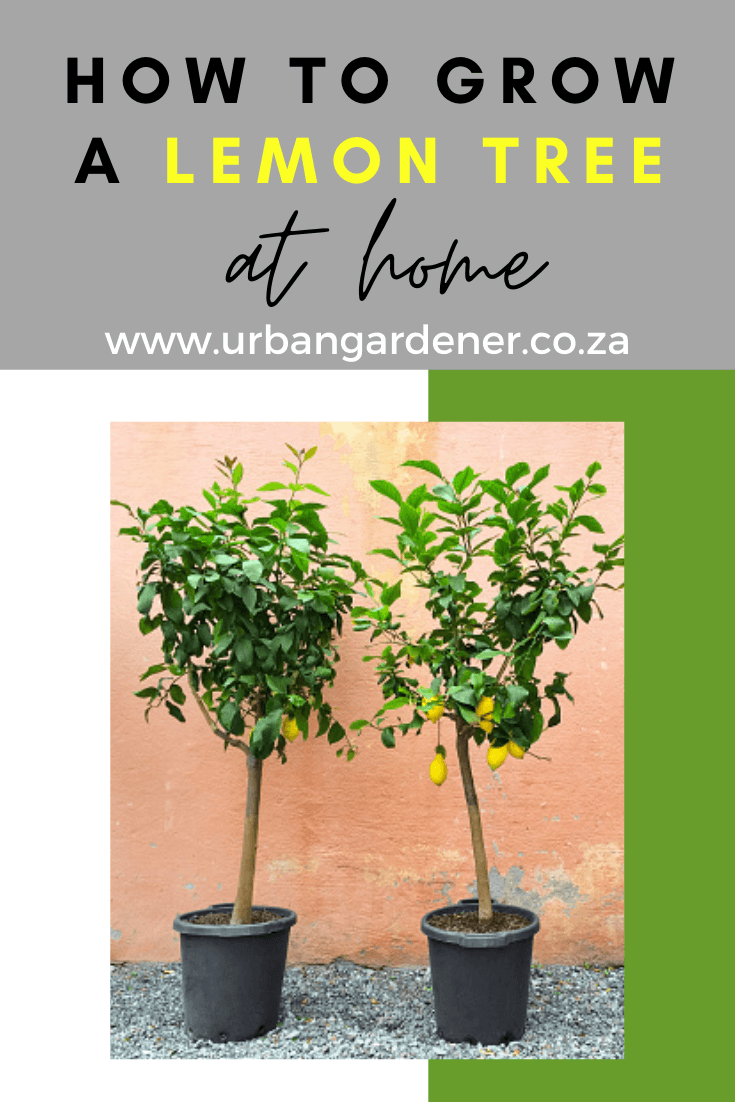A Step-by-Step Guide
Find out how to grow a lemon tree from seed – it’s easier than you think, but of course you’ll need to pay more attention than if you were buying tree from a garden center.
Growing your own garden can be a rewarding experience. It’s a great way to save money on groceries, especially since fresh produce is becoming more and more expensive. And, when the unpredictable happens (such as Covid-19, or the Ukrain/ Russia war that is affecting food prices), you can turn to your own healthy veggies and fruit that you’ve grown yourself and know that you and your family are going to be just fine.
Now most people think that to grow your own food plants you need to have a lot of space, but not everyone has the space for a full garden.
The great thing about growing a lemon tree is that they make perfect container plants so it will fit perfectly in an apartment or on a balcony, or you can place it inside in a sunny corner in your living room.
Lemon trees take less than six months to start growing and can make great indoor plants. The best part? They give offer a light, citrussy aroma making the air smell fresh. Don’t you just love that smell?!

Why grow a lemon tree?
Lemon trees are a great option for anyone looking to grow their own garden without the commitment of having to plant a full garden.
Growing lemon trees is also a great option if you have an apartment with no balcony or patio. Lemon trees are easy to grow, require little maintenance, and can be grown indoors.
The amount of time needed to grow a lemon tree from seed is less than six months. To start your lemon tree, you can purchase seeds or even easier, purchase a seedling from your local nursery.
The seedlings are already the correct height, so they do not need to be trimmed.
So, once you have your bright and beautiful bounty, what are you going to do with them?
- Leave your lemon tree as a decorative plant
- Use the rind of the lemon in baking
- Use your own lemons in baking, cocktails, lemonade, lemon curd
- Make homemade cleaning agents
- Make your own lemon juice and store it for cooking and baking
Keep reading to find out how to grow a lemon tree from seed!
Use the correct tools when growing a lemon tree
To get started growing from seed, you’ll need a few simple supplies:
- seeds
- potting soil or germination soil
- a pot for starting the seedling
Lemon trees aren’t very fussy with the soil as long as it has very good drainage.
When growing lemon trees in pots, clay pots are best because they are porous and allow evaporation through their walls.
This is perfect for lemon trees as they do not like to have ‘wet feet’.

Tips for growing your lemon tree in a pot
Here are a few tips to help you make growing your lemon tree in a pot less stressful.
Clay pots are better for the tree, yes, but a clay pot filled with potting soil is heavy. Think about this before you settle your pot plant because you can really hurt yourself if you don’t pick it up properly.
If you don’t want to use a clay pot you can use a wooden crate, or even a plastic one. Just make sure that there are draining holes and watch that the plastic pot doesn’t get too hot, or too brittle from the sun.
Moving the pot around
Either use a pot with handles, or attach wheels to the bottom of the container, or make sure that you are able to lift it up onto a wheelie board.
You can even make a board/ cart with wheels to move the container from place to place as you need.
Consider this especially during prolonged winters – lemon trees need to be kept warm to survive.
Soil requirements for growing a lemon tree
Soil requirements for growing a lemon tree are actually quite easy.
They need soil with good drainage. This means that heavy clay or heavy sand are not good options for lemon trees. Add a lot of aged manure and organic matter to provide your tree with the best nutrients possible.
The soil pH is also important. Use a pH reader to ensure the levels are correct – lemon trees prefer slightly acidic soil of around 5.5 – 7 so if your soil is too acidic or too alkaline, you will need to make the necessary adjustments.
Planting your lemon tree seedling
When your seedling is approximately 6 inches/ 15 cm tall, it’s time to get that baby into it’s own container.
Do this in spring or early fall to avoid the crazy summer heat.
- Choose a container with good drainage that’s large enough to fit your tree. Fill it with the potting soil that you have already prepared and water it.
- Dig a hole in the centre of the container, place the seedling in the hole and cover it in soil, so it has at least 1 inch/ 3 cm of dirt on all sides.
- The soil is already damp so when the plant is in the soil you can spray it again lightly. Place the pot in a sunny location.
- Once your seedling is established, water it at least once every 3 – 7 days.


Watering your lemon tree
The lemon tree has a fairly high water requirement, so if you’re going to be growing a lemon tree from seed indoors, make sure you have a plan for watering it.
This will depend on your climate, but in many climates, it may be necessary to water your lemon tree twice a day. In addition to frequent watering, you’ll also need to keep your soil moist.
Luckily, this can be done easily by either putting a saucer under the pot to catch the water from the bottom, and then the plant will absorb the water from the bottom as it needs. Otherwise, you can just continue watering from the top.
The goal is to keep the soil moist at all times, but not wet.
Fertilizing requirements
You’ll need to fertilize your lemon tree every couple of months. Fertilizer is an essential component of a healthy garden, and your lemon tree is no exception. In fact, the health of your lemon tree is dependent on it.
In order to fertilize your tree, you have a few options. You could purchase fertilizer from the store, or you could go with a homemade mixture. If you decide to make a homemade mixture, make sure your fertilizer contains the following:
Nitrogen: 10%
Phosphorus: 10%
Potassium: 5%
Sulfur: 5%
Micronutrients: 5%
This will keep your lemon tree healthy and thriving.
How much sunlight does a lemon tree need?
Citrus plants love the sun.
Try and put it in a place where it can receive 6 – 8 hours of direct sunlight per day. If this isn’t possible due to the climate where you live, you can grow a lemon tree indoors, in a greenhouse, or even in a sunny enclosed porch instead.
If you choose to grow your lemon tree indoors, put it next to a window.
If you live in the northern hemisphere then a south-facing window with lots of light is an ideal spot for your plant. If you live in the southern hemisphere then a north-facing window will be perfect.
If you still aren’t receiving enough light, you can use artificial lights to make up for the loss.
If choosing to grow your tree indoors, make sure to rotate your plant every day or two otherwise it will grow at an angle as it leans towards the light.
Repotting your lemon tree
Lemon trees need repotting approximately every 3 to 5 years.
The pot should be at least 25% larger than its current pot. Keep repotting it until its pot is approximately the size of half of a barrel container.
A top tip to remember is that even once your pot has reached this size, lemon trees do like to have their roots pruned and soil changed.
Trim off rotting roots that are limp and brown in color, as well as any roots that you can see are broken or damaged.
At this stage, you can cut back 2 to 3 inches (5 – 8 cm) of roots if you want to maintain your tree’s size. Once you are happy with your tree’s size and you have removed any decaying or dead leaves, you can set the tree into half of the soil that is required and water it, and then fill the rest of the container with soil and then water it again.
Make sure that there are drainage holes to allow excess water to run away so your plant isn’t sitting with wet ‘feet’.
Pests that attack lemon trees
There are a few really irritating and damaging insects that can attack your tree and cause it to die if not treated quickly.
The most common pests include:
-Spider mites
-Aphids
-Mealybugs
-Scale insects
An Introduction to Organic Gardening eBook has FIVE recipes for organic, homemade, safe ‘pesticides’ to help you get rid of these critters and not add any chemicals to your organic garden.
One option is to move your indoor tree outdoors if possible, to expose these pests to their natural predators. But this could also lead to more pests, or not work at all. If it is winter or the pot is too heavy, you will need to consider alternate solutions.
Option 1: Handpick off the pests and squish them.
Option 2: Mix 11 tablespoons of dishwashing liquid with 1 gallon/ 4 liters of water. Spray your lemon tree well, including the underside of the leaves.
Option 3: Use neem oil which is a naturally occurring pesticide found in the seeds of the neem tree. Spray the entire tree including the underside of the leaves.
The best thing you can do is try to prevent pests every getting their little ‘teeth’ on your plants, and companion planting is a great way to do that. It’s easy, it’s affordable, it’s organic, and it also looks pretty.
Get planting!
Growing lemon trees from seed isn’t that difficult, you just need to follow the processes and keep pests away.
Springtime is usually the flowering months with the fruits maturing around winter. They are great to grow in pots and are also decorative enough that you can keep them indoors.
Remember, when picking your lemons to leave a bit of the stalk attached the lemon and this will allow them to last longer. Enjoy!
Disclosure: Some of the links in this post are affiliate links. This means that if you click on the link and purchase the item, I will receive a small affiliate commission at no additional cost to you. All opinions remain my own.



Recent Comments